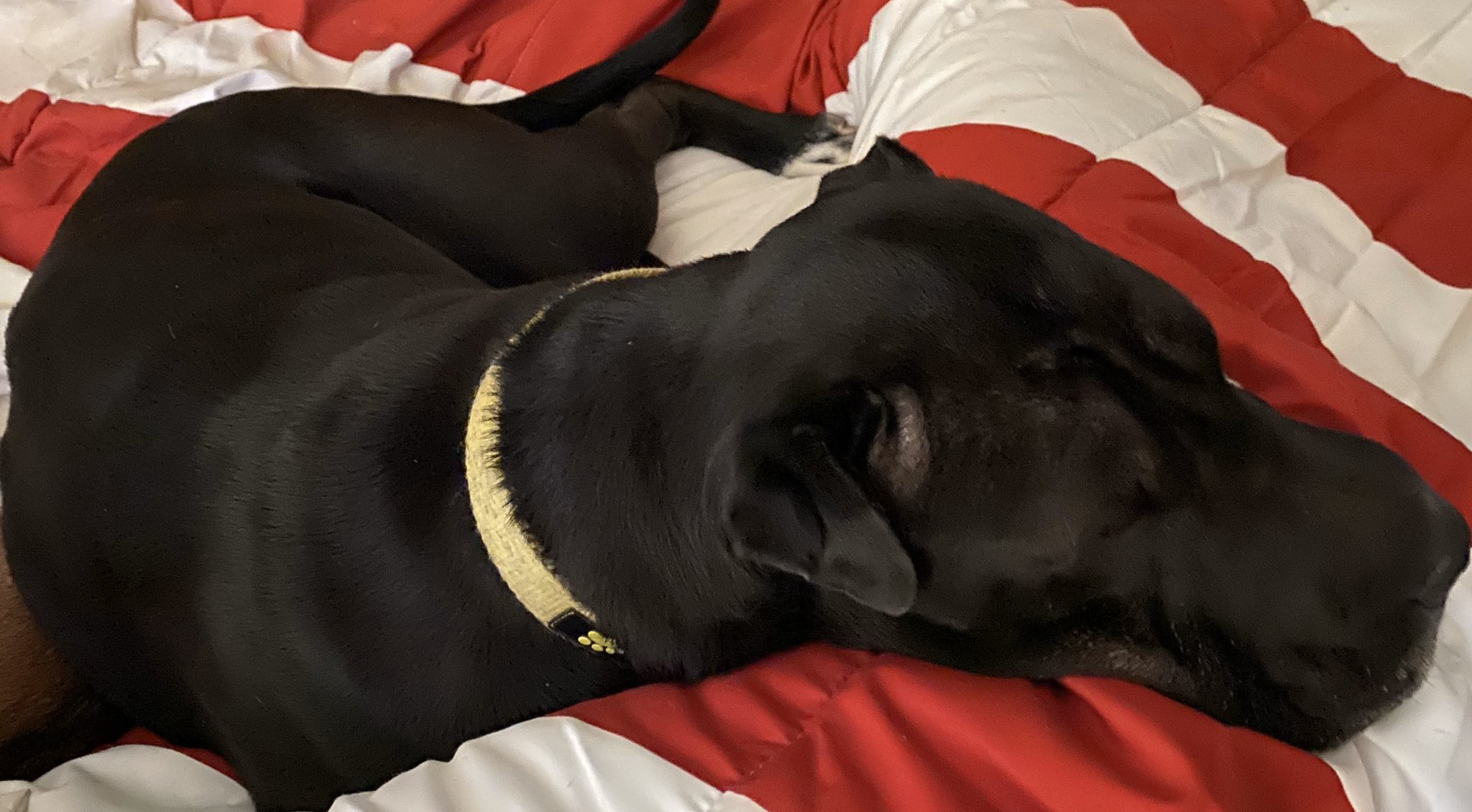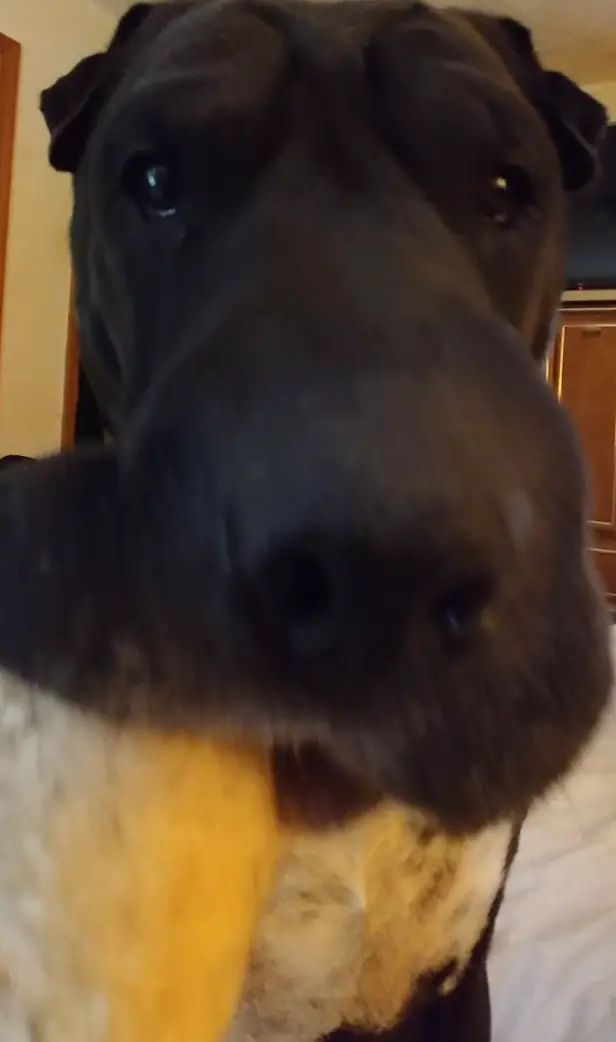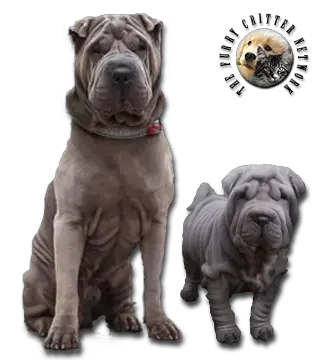Breed Standard
Head: Broad, flat skull. Slight stop. Profuse, fine wrinkles covering the forehead and cheeks continuing into side wrinkles and abundant dewlap. Large nose. Bluish-black tongue.
Ears: Small, fairly thick, triangular. Set on high, lying flat against the head.
Eyes: Deep set, small, almond shape. Dark color.
Body: Powerful and muscular. Strong neck with abundant dewlap. Broad, deep chest. Short back.
Tail: Medium length. Carried erect, straight, or tightly curled across the back.
Hair: Extremely short, horse coat. Extremely harsh to the touch (Shar Pei means sand skin in Chinese).
Coat: Only solid colors, black, tan, brown, beige, and cream.
Size: 40 to 51 cm (16-20 in).
Weight: Approx. 20 kg (44 lb).
History
This ancient Chinese breed has endured for centuries and still lives in provinces bordering the China Sea to the south. The Shar-Pei has been used as temple guard, fighting dog, hunting dog (boar), and herd guard. In 1947, dogs were officially outlawed in China, but some Shar-Pei's were exported to the United States from Hong Kong in 1970 and to Europe in 1980. One of the most unusual breeds in existence, the Shar-Pei is much sought after by fanciers who love its eclectic appearance. A miniature Pei (weighing 15 kg and measuring approximately 35 cm at the withers) also exists, but is not recognized by the FCI.
Behavior
Shar-Pei puppies need early socialization with children, strangers, and other animals. Like other fighting breeds, they can be stubborn, strong-willed and very territorial. Early training can help control these traits before they become problem behaviors. Some people may experience a sensitivity to the harshness of the coat of either length. This is a mild, short-lived rash that can develop on the skin that has been in contact with the coat, most commonly on the forearms.
The Shar Pei is often suspicious of strangers, which pertains to their origin as a guard dog. It is a very independent and reserved breed. Nevertheless, the Shar-Pei is extremely devoted, loyal and affectionate to its family and is amenable to accepting strangers given time and proper introduction at a young age. If poorly socialized or trained, it can become especially territorial and aggressive. Even friendly and well-socialized individuals will retain the breed's watch dog proclivities (like barking at strangers). It is a largely silent breed, barking only when it is playing or worried. The Shar-Pei were originally bred as palace guards in China. The breed is amenable to training but can be very stubborn. With repetition and a clear reward system, training is not very difficult. Overall, the Shar Pei can be a dog that is loyal and loving to its family while being very protective and independent.
This breed makes a good house dog as long as daily exercise is provided. Weekly brushing is sufficient. This dog must be kept extremely clean, and the folds in his loose skin require special care.
(Matt Bryant @ FCN) I was notified of the pending euthanasian of a Shar-Pei/Blue Nose Pit due to excessive aggression and extreme separation anxiety. She was a little over a year old. I adopted her and brought her to our farm. While I had no problem with the aggression, after gaining her trust, I did have a problem with the separation anxiety. She was very destructive when left alone. Over time, since I work from home, she finally realized that I would always come back on the rare occasions when I would leave, and I made every effort to have someone in the house with her at all times. Six years later (2022), at the time of this writing, she has become the most loyal and affectionate dog I have ever been in contact with. She loves to ride in my truck, but the aggressive nature shows anytime anyone gets within fifteen feet. She is very territorial and views everything as a threat to me. In the house she gets along very well with the other dogs, to the point of guarding their safety as well. Due to her nature I rarely take her with me in public due to her aggressive nature, but with that said she has become the finest companion with the family at our ranch. The breed standard and behavior for the Shar-Pei is spot on. She is my shadow and is never more the ten feet away from me. It's obvious to me that socialization must start at a very young age. It is also extremely important to be viewed by an aggressive breed as the alpha in the pack. I cannot stress this enough. This picture illustrates how we sleep every night. She's guarding me so nothing can harm me in my sleep. Shae has really turned out to be my best friend.


Function
Guard Dog, Pet.
Health
Because of its popularity after being introduced to North America in the 1970s, the breed suffered much inexperienced or rushed breeding. This resulted in not only a dramatically different look for the Shar Pei (as its most distinctive features, including its wrinkles and rounded snout, were exaggerated), but also many health problems. The American breed club states that few Shar-Peis reach the age of 10 and it has a longevity program recording those dogs that live to 10 years or more.
Compared to other breeds, Shar Peis have an increased risk of developing atopic dermatitis, a chronic allergic skin disease. Dogs with allergic skin disease often get allergy-induced skin infections. Shar Peis are also at an increased risk of demodicosis, a disease which happens when Demodex canis mites proliferate and cause skin irritation, inflammation and infection.
Familial Shar-Pei fever (FSF) is a serious congenital disease that causes short fevers lasting from 24 hours to sometimes up to three days and usually accompanied by accumulation of fluid around the ankles (called Swollen Hock Syndrome). Amyloidosis, a long-term condition, is most likely related to FSF, caused by unprocessed amyloid proteins depositing in the organs, most often in the kidneys or liver, leading eventually to kidney failure. The disease is associated with the Western type and it is estimated that 23% are affected. The Australian breed standard was changed in 2009 to discourage breeding for heavy wrinkling.
A common problem is a painful eye condition, entropion, in which the eyelashes curl inward, irritating the eye. If untreated, it can cause blindness. This condition can be fixed by surgery, "tacking" the eyelids up so they will not roll onto the eyeball for puppies or surgically removing extra skin in adolescent and older Shar-Peis. In Australia, more than eight in 10 Shar Peis require surgery to correct eye problems, contributing to them being the most expensive breed to insure.
The Shar Pei is also prone to chronic yeast infections in its ears. This is due to a tight inner ear structure with a wrinkled appearance, making cleaning very difficult; exacerbated by the tight "flap" that the ear creates over the canal, promoting a moist environment.
Vitamin B12 deficiency is a common problem in the Shar-Pei and is suspected to be hereditary.








